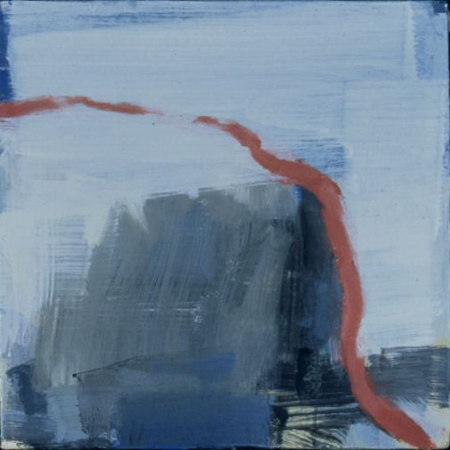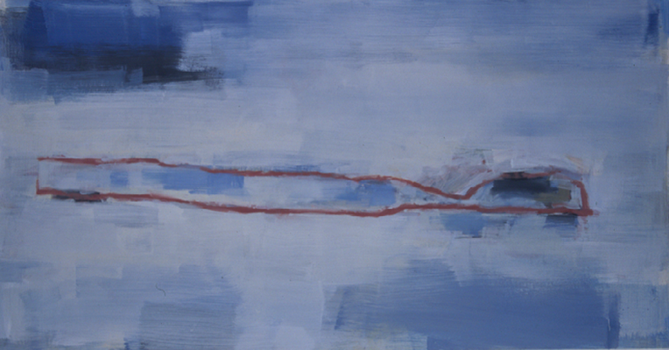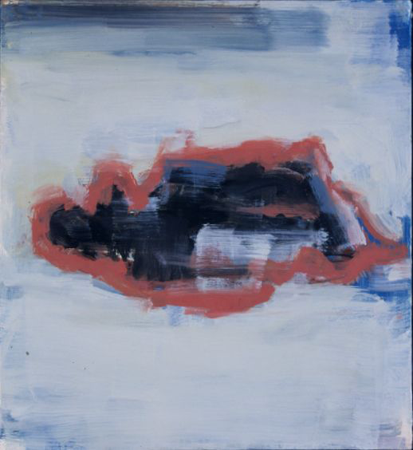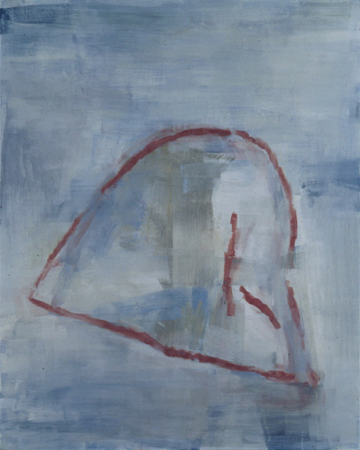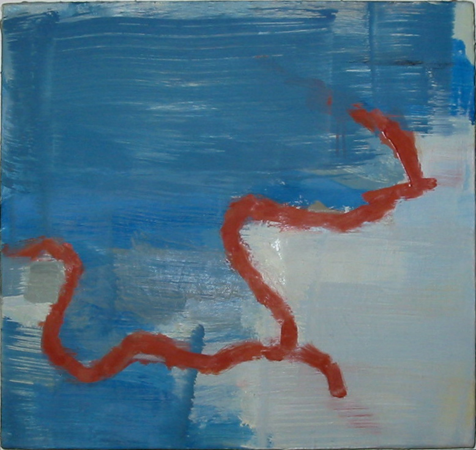Archaic Absolutes: Lex Braes' Scottish Ghosts
Donald Kuspit
Lex Braes has a doubly important position: within the tradition of gestural abstraction and within the tradition of emotional primitivism. No doubt they converge, but not necessarily. As Robert Goldwater points out, the original emotional primitivists - the Brücke and the Blaue Reiter artists - used figurative and landscape imagery to express intense, core emotions.1 But in such paintings as Fling and Ridge (both 1999) the human figure and the natural world are never more than ghostly suggestions. And while abstract gesture has become more and more autonomous in the twentieth century - liberated from structure and semblance (even at their most fleeting), until it finally becomes uncontainable and chaotic (in abstract expressionism at its most extreme) - Braes subtly reverses this process, for his grand gesture functions as a fragment of structure as well as a focused expression of primitive emotion. There is no loss of intensity, but the recovery and reconstruction, however tentative and fragmentary, of what is usually sacrificed to intensity, to primordial gesture: a relationship to and acknowledgment of the objective world, however subjectively modified. In Braes's case, the Scotland in which he grew up, and to which he still clings, in desperate nostalgia, however much it has lost its historical reality and become an archaic fantasy.
Braes's Ruhe paintings (1994) show that he has paid his expressionistic dues - spent his season in self-expressionistic hell. All his works are unusually self-searching, but the Ruhe series in particular plunge the psychic depths. Their implosive dynamics- the impulsive gestures seem like the emotional remains of a violent underground explosion, a traumatic upheaval in Braes's inner life - seem to belie the series title, in English, "rest, calm, silence." For the Ruhe pictures are restless, disquieted, anguished. They are superb examples of expressionistic outcry.2
But their point of departure - inspiration - is the female figure, as Braes tells us. We see her from the back in several drawings, shielding her sexuality from the voyeuristic viewer, her modesty making her more mysterious and seductive, Braes carries Degas's vision of the remote female body to an abstract extreme, where it dissolves into the extravagant emotions it arouses. He seems to pulverize eros, conveying his ambivalence toward woman. The same gesture caresses and obliterates her body. It transforms the fullness of her presence into painterly excess. For Braes woman's flesh is the whetstone on which he sharpens his painterly gestures, in a manner worthy of de Kooning. Excruciatingly intensified, the gestures become the substance of the figure. But however reduced to a subliminal presence in Braes's painterliness, woman remains the unmoved mover catalyzing expressionistic dynamics of his pictures. It is as though her latent power becomes manifest through it. She fuels his painterly gestures, giving them a consummate edge. In other words, woman is the static, solitary, silent center of the Ruhe series. Hence the emotional accuracy of the title: she is the stable center of Braes's emotional storm.
Braes tells us that while he is engaging the "universal picture of the female" - the female image or eternal feminine, as it were - he is also evoking the Scottish working class woman, whose strength was the "glue" that kept "everything together emotionally." Thus the woman in the Ruhe series is the personification of Scotland at its most determined and authentic- an allegorical figure, indicating that Braes's paintings are abstract allegories of Scottish fortitude and integrity in the face of adversity. In the Still series (1996-97), the next step in the story of Braes's mythologization - and metaphysicalization - of Scotland, he in effect extracts and distills her essence. The figure, already well on the way to losing its human particularity in the Ruhe series, becomes anonymous to the point of losing its gender identity in the Still series. It becomes completely archetypal and more haunting than before. Most crucially, while still a "strong symbol," as Braes called woman, it is no longer woman. It is the melancholy residue of Braes's Scottish self - of Braes the Scottish Dreamer, as a 1996 painting suggests. Braes lives in New York and Zürich, but he cannot es cape the deep emotion Scotland arouses in him - the emotion generated by his identification with it. It is this emotion, in all its complexity, that is epitomized in the peculiarly passionate, concentrated line that forms the figure's head. Meandering into humanly meaningful shape, it has an uncanny verve, in part because it coils back on itself, like a snake about to aggressively strike, but thinking the better of it. Braes's line is, in fact, peculiarly reptilian, even as it is warm-blooded and reflective. This primitive, isolated line, at once forceful and restrained, dense and insinuating, stark and richly colored - it seems a mixture of blood and earth - conveys the epic strength of the Scottish survivor as well as the lyric fancifulness of the Scottish dreamer. It fuses Braes the Scottish realist and Braes the Scottish poet. It also represents the Scotland he has forsaken and the Scotland that has been forsaken by the world, however much it remains alive in both the world's and his own imagination. It is Scotland that has been mortified but remains unforgettable.
The Clearing paintings (1999) are the climax of Braes's engagement with Scotland. They are the final fruit of the nineties - his final statement of his feelings about Scotland. It remains as resonant and memorable as ever, it has become more remote than ever. Braes's line - as always a masterful mix of spontaneity and control, impulse and calculation is the final vestige – one might say flicker or spark - of it. The line is handled with a new virtuosity, and acquires new integrity and autonomy. In the Still series it was painted against a more of less gray background, now and then illuminated with sudden flashes of pale color - a kind of muted light. In the Clearing series the line hovers in front of a more optimistic background. It is broadly painted in an almost virginal, delicate blue, the color of the sky and the lake in Zürich where the series was begun. There is an indwelling - rather than imported - luminosity, however much dark patches sometimes congeal and cloud it, like sudden squalls, dangerous but quickly passing. The turbulent density of the Ruhe series and the excited tension of the Still series have been replaced by a deep, new harmony, as though Braes' has resolved something in himself. The gestures are now like swift, deep currents, however still their surface seems. Braes has not lost his drive; it has gone underground, in deference to his new equilibrium, and subserving it. In short, one can trace a progressive stabilization and clarification through the nineties, suggesting a maturing self-recognition, and a mature recognition of Scotland.
Two symbols of it dominate the Clearing series: the so-called Three Sisters of Glencoe, a group of mountains whose contours are apparent in the Three Sisters and even more abstracted in Three Lines; and the Highland fling, alluded to in Fling No. 1 and Fling No. 2. In the first a ghostly kilt swirls out expansively; in the second two kilts fall back on themselves. It is as though we are watching Scotland breathe out excitedly and take a deep breath in, as though Braes has pictured the diastole systole of the Scottish heart. The Highland fling is full of jerky movements; they are embodied in Braes's line. It is the same dramatic, dancing line found in Celtic imagery, and it has been freshly epitomized and revived by Braes's abstraction of it. Braes has written; "Clearing symbolizes my ongoing exploration for a personal connection to an authentic Celtic spirit. That spirit has been perverted." Braes is a Scottish purist - so pure that he returns to the primitive Celtic roots of the sturdy Scottish spirit. Of course, the return can only be made mystically - in the mysticism of Braes's strong-willed, haunted line, peculiarly insecure for all of its energy.
Indeed, the instinctive line becomes more and more mystical - ghostly, abstract, sublime, involuted and tragic. It is the tragic trace of a mystical experience of Scotland, a ribbon of mourning for its loss. In Aonach Dubh - the Gaelic name for the middle mountain in the Three Sister range - it is a broken fragment, intelligible but barely coherent. Are the various new head paintings linear abstractions of Celtic helmets? In path the line is a simple horizontal structure cutting across cosmic space, ambiguously inner and outer. Eminence shows a similar linear stru cture, now opening within the picture rather than toward the infinite outside. Braes is deep in the space of his own psyche, looking at the horizon - trajectory - of his own existence. The mountains of Switzerland, where Braes spends a good deal of time, and the mountains of Scotland are implicitly one for Braes. For him, the best of both countries is their primitive unspoiled nature. Fishmouth is another expression of his Swiss experience. In his own words: "I was sketching a melted opening in a snow covered Alp. A first sign of spring, a local told me they're called ‘fishmouths.' Wonderful!" Braes's painting embodies his exclamation of wonder as well as his wondrous vision - an exclamation of nature itself.
Crucial to this introspective work, as well as all the others, is the sense of experiencing nature from a great, "metaphysical," distance, making it unreal, numinous and ultimate. When Braes engages the world historical, as in Kos, based on "a TV map of Kosovo's boundary lines with Montenegro to the left and Serbia above" - I presume it is a mountainous area - the event is at an infinite distance, turning it into a spectral hallucination, which it already is on the map. In all these works Braes is struggling to liberate himself from Scotland, even as he struggles to find its rugged spirit in himself, and express it with as much detachment and precision as possible. He wants to distance himself from it yet acknowledge its continuing hold on him. But he shows us that it already exists at a great distance, that can be crossed only in the existential imagination: it has faded away into the remote past, living on only in divine nature and a tourist dance.
Notes- Robert Goldwater, "Emotional Primitivism," Primitivism in Modern Art (New York: Viking 1967), pp.104-42
- H.I. Schvey, Oscar Kokoschka: The Painter as Playwright (Detroit: Wayne State University Press, 1982), p.23 notes that Kokoschka expressionism as "a silence broken by a cry" - for Braes the silence of the female figure broken by the cry of his emotions, which seem to implore her to turn her attention to him.
